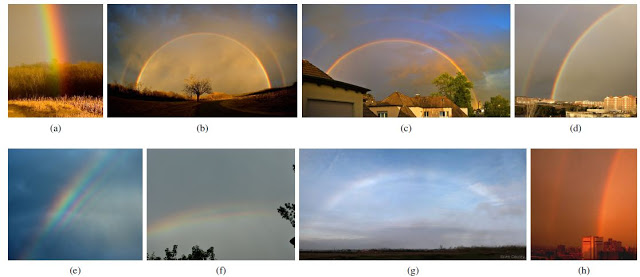
Unlike the more common double-rainbow, which consists of two separate and concentric rainbow arcs, the elusive twinned rainbow appears as two rainbows arcs that split from a single base rainbow. Sometimes it is even observed in combination with a double rainbow.
It is well-known that rainbows are caused by the interaction of sunlight with small water drops in the atmosphere; however, even though the study of rainbows can be traced back more than 2,000 years to the days of Aristotle, their complete and often complex behavior has not been fully understood until now.
"Everyone has seen rainbows, even double-rainbows, and they continue to fascinate the scientific community," said Dr. Wojciech Jarosz, co-author of the paper and Research Scientist at Disney Research, Zürich. "Sometimes, when the conditions are just right, we can observe extremely exotic rainbows, such as a twinned rainbow. Until now, no one has really known why such rainbows occur."
Jarosz and the international team of researchers studied virtual rainbows in simulation, considering the physical shape of water drops, and their complex interactions with both the particle and wave-nature of light. The key to the twinned rainbow mystery, Jarosz said, is the combination of different sizes of water drops falling from the sky.
"Previous simulations have assumed that raindrops are spherical. While this can easily explain the rainbow and even the double rainbow, it cannot explain the twinned rainbow," he said. Real raindrops flatten as they fall, due to air resistance, and this flattening is more prominent in larger water drops. Such large drops end up resembling the shape of hamburgers, and are therefore called "burgeroids".
"Sometimes two rain showers combine," Jarosz said. "When the two are composed of different sized raindrops, each set of raindrops produces slightly deformed rainbows, which combine to form the elusive twinned rainbow." The team developed software able to reproduce these conditions in simulation and the results matched, for the first time, twinned rainbows seen in photographs. The team also simulated a vast array of other rainbows matching photographs.
Credit: Disney Research
The team's discovery was unintentional. "Initially the goal was to better depict rainbows for animated movies and video games and we thought rainbows were pretty well understood," said Jarosz. "Along the way we discovered that science and current simulation methods simply could not explain some types of rainbows. This mystery really fueled our investigations." The researchers now see potentially wider application of their method beyond computer graphics, speculating that, some day, accurate rendering models of atmospheric phenomena, like the one they developed, could have impact in areas such as meteorology for deducing the size of water drops from videos or photographs.
The research findings by will be presented Aug. 8 in the "Physics and Mathematics for Light" session at SIGGRAPH 2012, the International Conference on Computer Graphics and Interactive Techniques at the Los Angeles Convention Center. For a copy of the research paper, please visit the project web site athttp://zurich.disneyresearch.com/~wjarosz/publications/sadeghi11physically.html.
Contacts and sources:
Jennifer Liu
Disney Research






